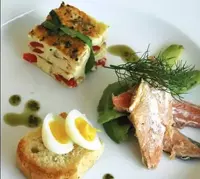Fusion

Recipes for fusion cuisine can be characterized as follows - free creativity without borders.
In the 80s of the XX century, a new culinary direction was born in America. The name of the culinary style of the author's cuisine came from the English word fusion, which means "fusion or splicing. "
The name of the fusion of the kitchen lies with its whole essence. Eastern traditions have become incredibly popular in America and Europe.
Many chefs of the 80s began to learn fusion cuisine. Cuisine fusion dishes are characterized by an unusual and even unexpected mixture of tastes, smells and ingredients. Some experts argue that it is wrong to date the appearance of fusion cuisine to the 20th century, because since ancient times, people have shown interest in various combinations of products.
If you look closely at some of the dishes of the national cuisines of the world, you can see the beginnings of the fusion direction. Immediately, the national dishes of the Asian region come to mind, where what is not a recipe, then an unexpected taste and a combination of ingredients. And in some European traditions, it is customary to serve meat fried on an open fire with a sauce of forest berries. And these are just the most obvious and obvious examples of the influence of cuisine fusion on national culinary traditions.
The main principle of fusion cuisine and its main difference from all others is the mixing of culinary traditions. It's as if you added Indian green curry sauce instead of mayonnaise, the familiar ingredients for Olivier salad. Often bold taste combinations in cuisine fusion dishes are incomprehensible to a simple layman. However, foodies and lovers of new sensations appreciated the recipes for fusion cuisine, which sometimes combine the incongruous. For example, oranges and tomatoes, cherries and fried onions, and octopus kitchen fusion cooks are served nothing more than with kiwi.
Fusion cuisine is attracted by its quirkiness, novelty and extraordinary, which is why this cuisine is becoming more popular in modern times. Often kitchen fusion chefs resort to an interesting technique. You are served dishes for the first, second and dessert, which belong to various culinary traditions. As a result, you get a mixture of culinary schools called fusion cuisine.
Many foodies reasonably believe that the author's and fusion cuisine are close in meaning and content. After all, the cook who prepares the author's cuisine himself comes up with recipes based on culinary knowledge and experience. Basically, the cook mixes different culinary traditions and gets new dishes of his own. A cook who makes kitchen fusion recipes does the same.
Recipes from Asian countries are often taken as a basis and ingredients familiar to Europeans and Americans are added to them. Often, some spices and spices are excluded from oriental recipes in order to make the taste of the dish softer or not so spicy. American and European chefs are considered recognized masters of fusion cuisine.
In Europe, in the fusion restaurant of the kitchen, you can taste interesting and unusual dishes - beetroot salad with the addition of pesto, parmesan and nuts, buckwheat salad with mushrooms and shallots or from watermelon and goat's cheese, gazpacho soup based on white wine, as well as deer meat cooked in chocolate sauce. For dessert, you can taste chocolate cake, which is made without flour, apple and lavender pies, vegetable pies, as well as pineapple curries.
However, be reasonable. Everyone can mix strawberries with garlic, add vegetables and call it a recipe for fusion cuisine, except this does not mean that the new dish will be edible or will appeal to anyone.
 Español
Español Français
Français Português
Português Русский
Русский 简体中文
简体中文 繁體中文
繁體中文 日本語
日本語 한국어
한국어 العربية
العربية Türkçe
Türkçe Қазақ
Қазақ Deutsch
Deutsch Italiano
Italiano Українська
Українська
